Unit 4 Where’s my schoolbag?
听说课 第四课时 Section B (1a-1e )P22
Teaching Goals:
1.使用下列词汇(Curriculum words),tape, hat.,clock,tape player, model plane P22
2.准确描述物品所在的位置
Where's your notebook/keys ?
It’s /They're in /on /under…
3.情感目标
A. 培养学生整齐地摆放自己物品的生活习惯;
B.通过小组对话、讨论、调查和设计等一系列的课堂活动,培养学生的合作精神。
Teaching and learning steps:
Step1.Pre-listening activities.
1.Review 【温故】
Review the main target languages of Unit4 .
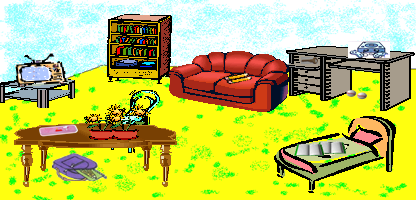
T: Boys and girls, look at the picture. What’s this in English?
Ss: It’s a schoolbag.
T: Where is the schoolbag?
Ss: It’s under the table.
T: Great! Next, please practice this conversation with your partner.
Ask some students to show their new conversations.
A: Where is/are the …?
B: It’s /They’re in/on/under…
T: Let’s chant.
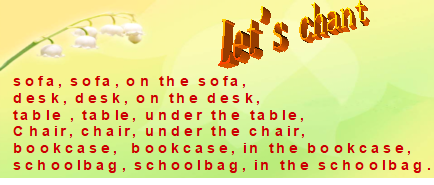
【设计意图】:本单元主要是学习如何询问和回答物品所处的位置,因此本部分既是对Unit4 Section A目标语言的复习,又为本节课谈论到的目标语言做好铺垫。最后用chant的形式加以小结。
2. Preview 【知新】
Ask the students to translate the following Chinese into English.
(1)在桌子下面_________ (2)在书橱里_________ (3)在我的背包里_________
(4)在沙发上_________ (5) 在床下面_________
Ask the students to translate the following sentences.
(1)我的铅笔在哪里?___________________________
(2)它们在沙发上。 ___________________________
Check the preview.
T: Boys and girls, let me check your preview. If you know the answers to the phrases, you can stand up .
【设计意图】:课前检测重点短语和句型,课上有针对性的听讲,更能培养学生的自主学习能力。通过抢答的方式来检测预习效果,充分增强学生的竞争意识,掀起学习高潮,学生很快进入状态;教师还可以学定教。
3. Lead-in and learn.
T: Boys and girls, look at the picture.

What can you see in the room?
Ss: Books, schoolbag.....
T: There are some new things in the picture.
Look at the pictures and learn.

T: Now turn to P22 and match the words with the things in the picture.
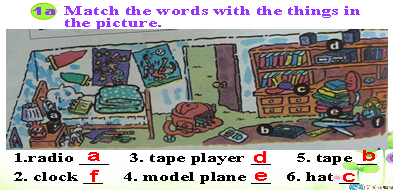
T:(1b )Look at the picture in 1a for two minutes. Then close your books and write down all the things you remember.
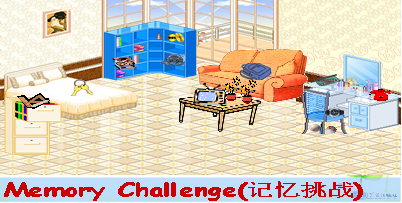
【设计意图】:教师通过Memory Challenge(记忆挑战)的游戏,引导学生记住新单词,增加其趣味性,并为1c听力做好铺垫。
Step2. While-listening activities.
Listening Practice
1.Listen for the general idea听取大意
T: Boys and girls,please listen to the recording carefully and find out the main idea of the conversation.
The main idea (大意) of the conversation is _____.
A. to know your dream room
B. to draw a picture of your room
C. to know your room and where the things are
【设计意图】:让学生通过听录音整体感知,并找出谈论的主旨大意。听前要对学生进行相关听力策略(听前先仔细审题,找出需要听的关键词,即用下划线标注的词)的指导。这样能提高学生整体理解听力内容的能力,帮助学生更好的完成听力任务。
2.Listen for the specific ideas听取细节
(1)T: Now we’re going to listen to a conversation between Tommy and Mom. Listen carefully and circle the things Tommy wants from his room.
(2)Check the answers.
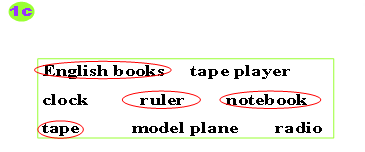
(3)1d T: Listen again. Where are Tom’s things? Write them down.
The English books _______under the___________. The ruler is_______ ___________ _______________.. The notebook is _________the model plane in ____________ ___________. _____________ __________is in the_________ player. |
Check the answers.
The English books are under the radio.
The ruler is on the bed.
The notebook is under the model plane in the bookcase.
The tape is in the tape player.
【设计意图】: 在第二次听力之前,一定注意引导学生快速浏览方框中句子所缺的单词,降低听力难度,并且给予听力策略的指导:即注重关键词under, on, in等。在核对答案的时候,老师可以先给学生做个例子,引导学生用目标句型,然后学生根据听力内容来回答。)
3. Listen and fill in the blanks.
Mom: Hello.
Tom: Hi, Mom. Could you bring(带来) some things school for me?
Mom: OK.
Tom: I need(需要) my___________ books….
Mom: English books? your English books?
Tom: Hmm, they’re the chair…Oh, no, they’re under the .
Mom: OK.
Tom: And I need my .It’s .And my .
Mom: Where’s your notebook?
Tom: Uh, I don’t . Oh, it’s under the in the bookcase.And Frank’s . He needs it.
Mom: his tape?
Tom: Oh, it’s in the .
Mom: OK. Meet you at one .
Tom: , Mom.
【设计意图】: 听并填出空缺的单词,注重对听力细节的处理,考查学生的听力理解能力和书写能力,并加深学生对介词用法的掌握,为下一步小组做对话及小组合作探究做好铺垫。
4. Listen and repeat.
Let students listen to the recording and repeat after it to get their pronunciations right.
【设计意图】:跟读部分是为了正音,让学生模仿录音的语音和语调,对培养学生的语速、语调是很有帮助的。
Step3.Post-listening activities.
1.Pairwork. 1e 结对活动
Ask and answer questions about the things in Tom’s room. You can do like these…..
A: Excuse me? Where’s the clock? B: It’s on the desk. A: B: |
A: Excuse me? Where are English books? B: They’re under the radio. A: B: |
First, the teacher will ask one student to make a model with him/her.
Then, let the students work in pairs and make their own conversations.
Finally, ask some pairs to act.
【设计意图】:通过对话练习,进一步巩固本节课目标语言,让学生学以致用。在对学生进行知识教育的同时渗透情感教育。教育学生做事情要有条理性,机遇属于有充分准备的人。
 2. Retell.
2. Retell.
选做一:
Tom needs these things: his English books, his notebooks, his ruler and the tape. Where’re his English books? They’re____ the radio. And his ruler is_____ the bed..His notebook is________ the model plane______ the bookcase. Oh, and Frank’s tape is ________the tape player.
【设计意图】:此环节设计适合中下等生,填入适当介词形式,这是易错点。他们很难根据关键词来复述听力内容,即便他们能把短文中的短语填上,训练他们的思维能力和语言表达能力。把听力内容表述出来也是一种胜利!
 选做二:I am a designer.
选做二:I am a designer.
Teacher says,
“We all have our own room and want to make it more beautiful. Now let’s design our room. You can say: The CDs are on the bookcase...”
【设计意图】选做二适合优等生,让他们根据所学句子来复述,训练他们的思维能力和语言表达能力。
Step4. Summary Inquiry into knowledge by translation.
1. Ask the Ss to look at the following sentences and try to summarize the language rules about how to use “in, on, under” and fill in the blanks.
*His pen is in the pencil box.
* My keys are on the bed..
* Her baseball is under the chair.
in, on, under 是方位介词。
in 的意思是, on 的意思是___________________, under 意为_______________。
(1) Your book is______ the schoolbag.
你的书在书包里。
(2) The keys are ______ the table.
钥匙在桌子上。
(3) My baseball and schoolbag are _____ the ______.
我的棒球和书包在椅子下面。
2. Ask the Ss to look at the following sentences and try to summarize how to tell the place of a thing.
* The English books are under the radio.
* The ruler is on the bed
我总结:
介绍某物品的位置:______________________________________________________________
Check the Ss’ answers:主语+ is/ are+ in/ on/ under短语
 Step5当堂检测
Step5当堂检测
Ⅰ.将下列句子与相应的图片配对。

( ) 1. The ball is on the box.
( ) 2. The ball is in the box.
( ) 3. The ball is under the box.
Ⅱ.根据图片完成对话。
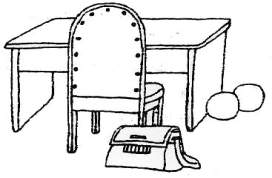
A: Can you see a bag in the picture?
B: Yes, I 1 .
A: Where is the 2 ?
B: 3 it in the desk?
A: No, it 4 . It’s behind (在…后面 )the chair. Can you see the balls?
B: Yes, I can.
A: Where are 5 ?
B: Are they under the desk?
A: 6 , they aren’t. They’re 7 the floor. Oh, 8 are my books?
B: I think they’re 9 the bag.
III.翻译下列句子
1. - 笔记本在哪?________ ________ ________ notebook?
- 它在床上。 ________________ on the bed..
2. 书在书橱里。The books______ ______ ________ _________.
3. 他的背包在椅子上。His schoolbag is ______ _________ __________.
4. -- 她的钥匙在桌子下吗?________ her keys _____ ________ _____________?
-- 不,不在。No, ________ _________.
Step6 Homework.
1. Review the words and phrases in part 2b
2. Write a short passage using the following things.(用所给的物品写一篇小短文, 说明摆放的位置)
教后小结:
本课时的教学目标是让学生学会描述物品的摆放位置,学会如何使用介词,鼓励学生自己用英语开口描述
亮点:本节课较成功地组织了两个活动。第一个活动是通过挑战记忆力强化了新词汇,同时复习训练上一节所学的语言目标,并能给学生创造一个合作与竞争的环境,激发他们学习的积极性。第二个活动是在课本听力完成后自己设计自己的卧室,看谁是最好的设计家。此环节主要为学生创造轻松快乐的学习环境,让他们积极运用所学语言表达与描述事物的具体位置。
总之,整节课主题鲜明,但有不受课本限制,大胆地对教材进行拓展,让学生在轻松真实的活动中学会了语言。
不足:
在角色表演:找东西。这项活动可设计为小组活动。学生A在小组中模拟自己忘记带一些必要的物品,学生B扮演他/她的父母或朋友。学生A口头告诉学生B那些物品的位置,学生B需要对物品的具体位置做简单的记录,再向全班同学进行描述,以检查学生B描述的是否正确。通过完成此项活动,要求学生灵活运用所学的方位介词对物品的位置进行描述,同时也练习了学生的听力。但由于指令不明确,使得课堂有点乱。
使用建议:
1. 由于本课的容量较大,课前提前预习,以确保本课的课堂效率。
2. 课堂上设置情景练习方位介词,教师多鼓励学生张开嘴巴大胆说。
当堂检测答案:
I.将下列句子与相应的图片配对。I
1. ( B ) 2. (C )3. ( A )
Ⅱ翻译下列句子
1. Where is the notebook? It’s on the bed.
2. The books are in the bookcase.
3. His schoolbag is on the chair.
4. Are her keys under the table? No, they aren’t..
III根据图片完成对话。1. can 2. bag 3. Is 4. isn’t 5. they 6. No 7. on 8. where 9. in

